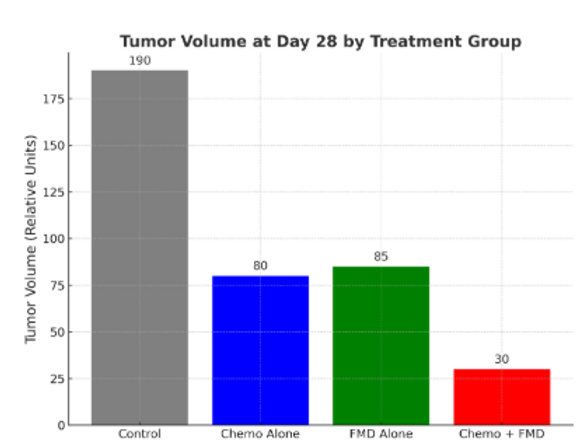Let’s face it, “anticancer diet” is a term that’s been used and abused. Juice cleanses, keto crazes, miracle mushrooms, and alkaline water, if I had a dollar for every fad pitched to my cancer patients, I’d have an avocado farm in the south of France by now. But what if I told you that there actually is a scientifically studied eating pattern that has shown real promise, not just for preventing cancer, but also for helping patients currently undergoing treatment?

The fast mimicking diet
A strategy developed by biogerontologist Dr. Valter Longo and his team, that could very well become a game-changer in how we approach cancer metabolism.
You’ve probably never heard of it (at least not from your average wellness influencer), but by the end of this article, you’ll not only understand how it works, you may be tempted to try a version of it yourself.
The science behind cancer and what it eats
Let’s start with the basics: cancer is a metabolic bully. It hijacks your body’s nutrients and energy to fuel its uncontrolled growth. Cancer cells are notorious sugar addicts, they thrive on glucose and often rely on a process called aerobic glycolysis (also known as the Warburg effect), where they ferment glucose for energy even in the presence of oxygen.
This dependence on glucose presents an opportunity. If you can starve cancer of its favorite food—or trick it into metabolic confusion, you might be able to slow its roll.
This is where the Fast Mimicking Diet (FMD) starts to shine.
What exactly is the fast-mimicking diet?
The FMD is not a traditional diet. It’s not even intermittent fasting in the way most people do it. Instead, it’s a 5-day, low-calorie, low-protein, high-fat, plant-based meal plan that puts the body into a fasting-like state without requiring complete food abstinence.
Dr. Valter Longo, Director of the Longevity Institute at the University of Southern California, developed the protocol after decades of research on aging, metabolism, and cancer biology. His studies suggest that this carefully calibrated diet mimics the effects of water-only fasting, cellular repair, ketone production, insulin drop, and growth factor suppression while still giving you just enough food to stay functional.
Let me say that again for emphasis: it’s ‘fasting without the fasting’. And that’s why it works.
How it impacts cancer cells vs. healthy cells
Here’s the elegant twist behind the Fast Mimicking Diet (FMD): it doesn’t treat all cells the same way.
That’s crucial, because when you’re trying to fight cancer, you want to be selective. You want a therapy that weakens malignant cells while shielding your healthy ones. FMD appears to do exactly that through a phenomenon Dr. Valter Longo describes as “Differential Stress Resistance (DSR)” and “Differential Stress Sensitization (DSS)”.
Let’s break that down.
1. Differential Stress Resistance (DSR): How healthy cells are protected
In a fasting or fasting-mimicking state, healthy cells enter a kind of protective “maintenance mode.” They downregulate growth signals like “IGF-1 (Insulin-like Growth Factor 1)” and “mTOR”, and upregulate repair and stress resistance pathways.
In short, they become more resilient.
Key effects on healthy cells:
- ↓ IGF-1: reduced growth signaling
- ↑ Autophagy: cellular cleanup of damaged components
- ↑ DNA repair and antioxidant defense
- ↓ Inflammation
- ↓ Insulin and blood glucose
Healthy cells recognize that nutrients are scarce and respond by conserving energy, focusing on survival, not growth.
In a 2015 Cell Metabolism study, mice and humans undergoing FMD cycles showed significant reductions in IGF-1, glucose, and CRP (a marker of inflammation), all while increasing markers of cellular regeneration after the fasting period ended.
IGF-1 dropped by 21% in humans after just three cycles of FMD¹.
2. Differential Stress Sensitization (DSS): How cancer cells become vulnerable
Cancer cells don’t play by the same rules. They are addicted to growth signals, especially IGF-1 and glucose, and they rarely have intact stress response pathways.
When FMD is introduced, cancer cells fail to adapt. They continue to grow despite the lack of nutrients, making them more vulnerable to stress, including chemotherapy or oxidative damage.
Key Effects on Cancer Cells:
- Unregulated proliferation even under stress
- Impaired ability to activate stress response
- Enhanced DNA damage under chemo
- Greater cell death in the fasting state
In mouse models of breast and melanoma cancer, FMD alone reduced tumor progression, and when combined with chemotherapy, resulted in a more than 50% reduction in tumor size compared to chemo alone².
Visual summary: How FMD affects cell types
| Cell Type | During FMD | Impact |
| Healthy Cells | ↓ IGF-1, ↑ autophagy, ↑ DNA repair | Enters protective mode; resistant to chemo toxicity |
| Cancer Cells | ↑ stress, no adaptive response | Sensitized to chemo; increased cell death |
Using FMD during active cancer treatment
Now, let me be clear: FMD is not a replacement for chemotherapy, radiation, or immunotherapy. But when integrated wisely, it may enhance their efficacy and reduce toxicity.
Some early studies (and anecdotal clinical experiences) suggest that patients who undergo fasting-mimicking cycles around the time of their chemo experience:
- Less nausea
- Fewer blood count drops
- Improved resilience between cycles
- Potentially better tumor response
Again, the mechanism here is that FMD sensitizes cancer cells while protecting healthy ones. But before you try anything like this during treatment, you must talk to your oncologist.
In multiple preclinical trials, combining FMD with chemotherapy achieved “synergistic effects”. One landmark study by Di Biase et al. in 2016 found:
- In colorectal and breast cancer mouse models: 1. Chemo alone: modest tumor shrinkage2. FMD + Chemo: significantly more tumor regression 3. Healthy tissue toxicity was lower with FMD
Tumor volume curves over 28 days
- Group 1: Control
- Group 2: Chemo alone
- Group 3: FMD alone
- Group 4: Chemo + FMD Group 4 shows the steepest drop in tumor volume³.

Summary: Metabolic jiu-jitsu
FMD uses a kind of metabolic sleight of hand, starving cancer cells of their fuel, while giving healthy cells a protective shield. In a clinical context, this could mean:
- Better response rates to chemo
- Fewer side effects (nausea, fatigue, cytopenias)
- Greater patient tolerance for multiple cycles
- Lower inflammation and long-term recurrence risk
Now here’s where things get fascinating.
Cancer cells hate fasting. They thrive in nutrient-rich, inflammatory environments, often stimulated by high insulin and IGF-1 (Insulin-like Growth Factor 1). Fasting, or mimicking it, reduces both. In animal studies and early human trials, FMD has been shown to:
- Reduce IGF-1 levels (a known driver of cancer growth)
- Promote autophagy (cellular “self-cleaning”)
- Make cancer cells more vulnerable to chemotherapy
- Protect healthy cells from chemo-related damage
This is what Longo calls “Differential Stress Resistance” and “Differential Stress Sensitization”: healthy cells become more resilient during fasting, while cancer cells become more fragile.
Let that sink in.
Imagine a treatment window where the body is primed to protect its good soldiers and expose the enemy. That’s the promise of FMD when used alongside conventional therapies.
What the research says
While more large-scale human studies are underway, early findings are promising.
- In a 2020 randomized controlled trial published in “Nature Communications”, Longo’s team showed that FMD cycles improved metabolic markers, reduced body weight and abdominal fat, and decreased levels of IGF-1 in healthy adults, markers associated with lower cancer risk.
- In preclinical mouse models, FMD reduced the progression of multiple tumor types, including breast, colon, and melanoma. It also enhanced the efficacy of chemotherapy while reducing its side effects.
- In small pilot studies in breast and prostate cancer patients, FMD appeared safe and well tolerated, even during chemo cycles, while improving quality of life and reducing treatment-related fatigue.
Potential benefits for cancer prevention
If you’re not battling cancer but want to reduce your risk, FMD could still be a powerful tool.
It targets major aging and cancer risk pathways, insulin, inflammation, IGF-1, and oxidative stress. By cycling through FMD just 3-4 times per year, you may be able to “reset” the body’s metabolic clock, encourage cellular cleanup, and promote tissue regeneration.
It’s like spring cleaning for your cells.
And unlike daily restrictive dieting (which, let’s be real, most of us abandon after three weeks), FMD doesn’t ask for daily discipline, it asks for five days at a time, a few times a year. Science calls that compliance-friendly.
You don’t have to be in active cancer treatment to reap the potential benefits of the Fast Mimicking Diet. In fact, prevention might be where FMD has some of its most exciting and accessible applications.
Let’s zoom out for a second. Most of the chronic diseases that afflict us, including cancer, are not the result of sudden events. They’re the result of slow, cumulative metabolic shifts that take place over years or even decades.
And cancer, at its core, is a disease of dysregulated cell growth and metabolic overdrive. So anything that can recalibrate those metabolic pathways and regularly reset the body’s internal balance could, in theory, reduce the risk of malignant transformation.
That’s where FMD comes in.
FMD targets the hallmarks of cancer risk
When Valter Longo and his colleagues designed the FMD, they weren’t just focused on calorie reduction. They engineered it to influence some of the most well-known biological pathways associated with cancer development, including:
| Biological Target | Effect of FMD |
| IGF-1 (Insulin-like Growth Factor 1) | ↓ Reduced levels → less growth signaling |
| mTOR (mammalian Target of Rapamycin) | ↓ Inhibition → slows abnormal cell proliferation |
| Insulin + Glucose | ↓ Lowered → reduced fuel for pre-cancerous and cancerous cells |
| Inflammation (CRP, IL-6) | ↓ Downregulated → less DNA-damaging oxidative stress |
| Autophagy & DNA Repair | ↑ Upregulated → improved cellular cleanup and stability |
In short, FMD creates an internal environment less favorable for cancer to develop.
Evidence from human and animal studies
Let’s move from theory to data.
1. Human pilot trials (2015-2020)
In a series of small-scale human studies led by Longo’s group, periodic FMD cycles (5 days/month for 3-6 months) led to:
- 21-25% reduction in IGF-1 levels
- 5-10 lbs average fat loss (especially visceral fat, a known carcinogen producer)
- Decreased inflammatory markers like CRP
- Improved blood pressure, cholesterol, and fasting glucose
These metabolic shifts are all strongly associated with reduced cancer risk—particularly for breast, colorectal, endometrial, and pancreatic cancers, which are closely tied to obesity and insulin resistance⁴.
2. Animal studies
In mice genetically predisposed to develop cancer, FMD cycles delayed tumor onset, reduced the number of cancers that developed, and even reversed some precancerous lesions.
- In one landmark study, mice on periodic FMD had 45% fewer tumors compared to controls.
- In another, the FMD reduced insulin and leptin levels—two hormones known to fuel tumor growth⁵.
How often do you need to do it?
Here’s the part people love: you don’t have to fast every week.
Most prevention protocols using FMD recommend 1 five-day cycle per month, for 3 to 6 months per year. In Longo’s trials, that was enough to create lasting improvements in:
- Body composition
- Metabolic health
- Inflammatory markers
- Perceived energy and well-being
This infrequent nature means higher compliance and lower risk of burnout—unlike daily restrictive diets that often fail after a few weeks.
Bonus: It’s not just about cancer
While this article focuses on cancer prevention, FMD also shows potential in reducing risk factors for:
- Type 2 diabetes
- Cardiovascular disease
- Neurodegenerative conditions like Alzheimer’s
- Autoimmune disorders
All of these share common pathways of inflammation, metabolic dysfunction, and immune dysregulation, targets FMD hits with precision.
Who might benefit most from FMD for prevention?
FMD might be especially beneficial for individuals with:
- A strong family history of cancer
- BRCA1/2 or Lynch syndrome mutations (under physician supervision)
- Obesity or insulin resistance
- Metabolic syndrome (high triglycerides, blood pressure, belly fat)
- Chronic low-grade inflammation
- A desire to “reset” their metabolism without extreme dieting
FMD as a tool for “Metabolic reboot”
Think of periodic FMD as a “reboot switch” for your metabolism. It’s not about deprivation—it’s about strategic, brief metabolic stress that prompts your body to clean house, reset its balance, and emerge stronger on the other side.
In the context of cancer prevention, it’s one of the most promising, least-invasive, and most biologically sophisticated strategies we have today.
Not bad for a diet you’ve probably never heard of, right?
Cautions & contraindications
FMD is powerful, but it’s not for everyone. The following groups should not attempt it without careful medical supervision:
- Underweight individuals (BMI <18.5)
- Those with eating disorders
- Pregnant or breastfeeding women
- Diabetics on insulin or sulfonylureas
- Patients with cachexia or severe nutritional compromise
- Children and adolescents
In oncology specifically, those with significant weight loss, frailty, or poor performance status should approach FMD with caution. It’s not a one-size-fits-all intervention.
What a 5-day FMD cycle looks like, plus transition days
The original protocol, as designed by Dr. Valter Longo and his team, spans 7 days in total:
- 5 days of the actual fasting-mimicking phase
- 2 days of transition back to normal eating
Each component plays a vital role in achieving the metabolic and cellular benefits of FMD without stressing the body unnecessarily. Let’s break it down.
The 5-day fasting mimicking phase
During these five days, the goal is to trick your body into a fasting state while still providing minimal nutrition to maintain basic energy levels and safety. The key features of this phase include:
| Day | Calories | Macros (% of calories) | Key Characteristics |
| Day 1 | – 1,100 kcal | – 10% protein, – 34% carbs, ~56% fat | Gently lowers IGF-1, insulin, and glucose |
| Days 2–5 | – 750–800 kcal/day | Same macro ratios | Sustains ketosis, boosts autophagy, lowers inflammation |
Why so low in protein?
Protein stimulates IGF-1, a key growth signal. Suppressing this signal is vital during FMD because elevated IGF-1 is linked to cancer risk and progression. That’s why FMD is plant-based and low in protein, especially animal-derived.
Why moderate carbs?
You’re not going keto. Instead, this moderate-carb intake keeps the body just above starvation but low enough to promote ketone production and metabolic switching.
Why high fat?
Fat helps maintain satiety, energy, and brain function during fasting. Think olives, avocado, and nuts.
Sample DIY meal plan for 5 days
Note: This is a food-based alternative, not the commercial ProLon kit.
| Day | Meal example |
| Day 1 | Avocado + steamed greens + nut-based bar + lentil soup |
| Day 2 | Herbal tea + walnut pesto zoodles + roasted cauliflower |
| Day 3 | Mushroom broth + steamed spinach + olives + flax crackers |
| Day 4 | Butternut squash soup + kale salad + 1 tbsp olive oil |
| Day 5 | Cucumber-avocado soup + carrot sticks + a few almonds |
Hydration is key: Aim for 2–3 liters of water daily. Herbal teas and small amounts of vegetable broth are also allowed.
The 2 transition days: Easing back in
After fasting, you might feel tempted to dive into a cheeseburger or a glass of wine. Don’t.
Your body has just gone through a low-calorie, anti-growth, anti-inflammatory state. Jumping straight into heavy, rich, or high-glycemic foods can shock your metabolism, spike your insulin, and undo some of the cellular benefits you just gained.
That’s where transition days (days 6 and 7) come in.
Why the transition period matters
- Avoids Refeeding Syndrome (especially in low-BMI individuals)
- Supports stem cell activation and regeneration (which kicks in after the fasting period ends)
- Prevents brain fog, blood sugar crashes, and digestive distress
- Allows a gentle ramp-up of digestive enzymes and insulin response
What to eat on transition day
These days aren’t about continuing calorie restriction, they’re about gentle reintroduction of whole, nutrient-dense foods in small portions:
Day 6 (Transition Day 1)
- Breakfast: Cooked oatmeal with chia and a few berries
- Lunch: Steamed sweet potato + spinach + 1 boiled egg (or tofu)
- Dinner: Lentil soup + olive oil drizzle + avocado slices
- Snacks: Herbal tea, soaked almonds, fruit
Day 7 (Transition Day 2)
- Breakfast: Smoothie with spinach, banana, nut butter, and flax
- Lunch: Quinoa salad with cucumbers, tomatoes, chickpeas, lemon dressing
- Dinner: Baked zucchini + brown rice + tahini
- Snacks: Hummus + carrots, light fruit
Avoid:
- Processed foods
- Sugar-heavy desserts
- Heavy meats or fried foods
- Alcohol or caffeine
- Light activity, this isn’t the time for the HITT workouts
How you’ll likely feel
- Day 1–2: Mild hunger, light fatigue, maybe foggy
- Day 3–4: Brain clarity, energy, ketosis begins
- Day 5: Often calm, light, mentally sharp
- Day 6–7: Regeneration mode – stem cell and immune system activity increases
The original FMD protocol (commercialized as ProLon®) includes pre-packaged soups, nut bars, herbal teas, and supplements such as multivitamins and plant-based omega-3 oils.
Repeat this cycle every 1-3 months for prevention, or as advised by your oncology team during treatment.
So, is this the anticancer diet of the future?
We’re not talking about a silver bullet, but the Fast Mimicking Diet is one of the few interventions that bridges the worlds of cancer biology, longevity science, and nutrition with real evidence behind it.
It’s not sexy. It doesn’t promise overnight miracles. But it’s grounded in solid science and offers a promising tool in the fight against cancer, whether you’re trying to prevent it, endure treatment better, or bounce back stronger.
So the next time someone tells you about the latest “superfood,” smile politely but remember: the most powerful anticancer diet you’ve never heard of… might just be the one that lets you eat less.
Final word
If you’re curious about trying the FMD or want to incorporate it into your wellness or cancer care plan, talk to your healthcare team first. Fasting is powerful medicine, and like all medicines, it should be used thoughtfully.
This might not be the diet trend of the moment, but it may very well be the diet of the future.
Stay curious. Stay empowered.





